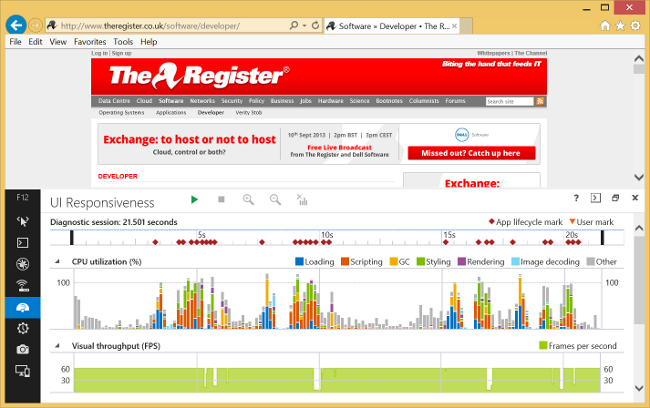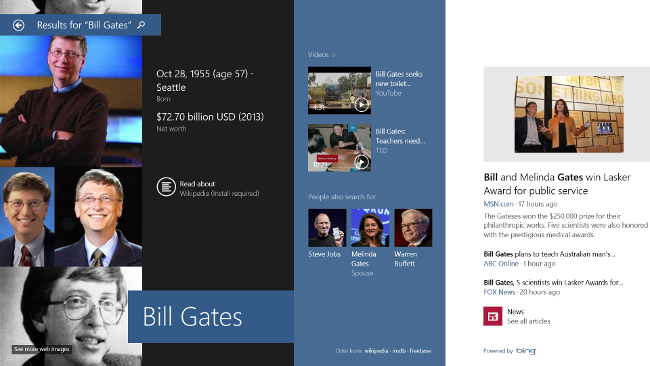This article is more than 1 year old
Windows 8.1: Microsoft's reluctant upgrade has a split-screen personality
El Reg has a sniff around the RTM version
Split-screen personality: Two browsers, two environments
Windows 8.1 retains the awkwardness of two web browsers, one in the Modern environment and one on the desktop, but these are now upgraded to Internet Explorer 11. This is a significant update, though the user interface is little different. Press F12, for example, and a new and improved developer tools panel appears, with a analyser, JavaScript debugger and more.
On the standards front, IE11 has WebGL support (though still somewhat behind that in rival browsers according to this demo list), improved Canvas support, high DPI (screen resolution) support, improved touch support with features like press and hold to simulate mouse hover, and a range of other improvements.

New and improved developer tools panel include analyser, JavaScript debugger and more
SkyDrive is now more deeply baked into the operating system. It is also cleverer than before, with the entire contents of SkyDrive folders visible, but only downloaded on demand, unless you right-click and choose "Make available offline". Pictures are represented by thumbnails unless you demand the whole file. The SkyDrive Store app now supports the same offline cache as the desktop version.
Talking of Store apps, the way these work has changed. Microsoft developer evangelist Jerry Nixon helpfully identifies the key differences while observing: “New Windows users had serious trouble with some Windows 8.0 features. Even tenured Windows users had deep adoption anxiety.” In other words, Microsoft made some fundamental mistakes in its first go at a tablet user interface.
Second time's a charm
The changes begin with search. Users, as Nixon explains, do not find the Windows 8 Charms bar intuitive as a way of searching within an app, so the new guidance asks app developers to put search controls within the main user interface, using a new SearchBox control.
The second change is Microsoft now encourages a more flexible approach to app design, rather than following guidelines that are rigid to the point of repetitiveness, including a smaller primary grid unit of 5x5 units instead of 20x20. In consequence, future Store apps may be less wasteful of screen space.
Third, the fixed split view in Windows 8.0, when two apps are shown side by side, has gone. Now users who figure out the gesture for displaying two apps simultaneously can size them as they wish, though the split is horizontal only. You can also display more than two apps if your screen is big enough, and have Store apps on multiple displays.

Second time without the Charms - Windows 8.1 attempts more intuitive search
Store apps, which are built on a set of APIs called the Windows Runtime, gain new capabilities in Windows 8.1, including support for USB and Bluetooth devices, and new controls including Hub, Flyout and Date and Time pickers. There are also enhancements to existing controls. Developers I spoke to at Microsoft’s Build conference in June seemed happy with the changes. “It’s caught up with Silverlight,” one told me: faint praise perhaps, but showing that the 8.0 app platform was not ready.
The Search app also deserves a mention. Search “Everywhere” from the Charms menu, and an app pieces together local and web results into a multimedia view that works brilliantly for certain types of search. It is an excellent app. The question is: will users who are stuck in the desktop ever discover it? That question expresses Microsoft’s difficulty. The more it steers users towards the Windows 8 tablet platform, the more complaints it gets from bemused and often conservative Windows users. The more it enables user to stay in the desktop environment, the harder it becomes to establish its new app platform.
Windows 8.1 is a generous free upgrade and users of Windows 8.0 should not hesitate to upgrade. It also improves on Windows 7.0, the caveat being it requires some adjustment and learning, which users who are not interested in the tablet app platform may, reasonably enough, be unwilling to give. That said, the improved usability means it will be more acceptable to consumers and something that businesses, after suitable customisation, are more likely to deploy.
A decent release, then, but one that still leaves open questions. Will Microsoft ever fully establish the Store App platform, with its still-disappointing range of apps?
Will Windows 8.1 ever be perceived as a tablet platform, rather than as a way to run desktop apps because you have to? Will Microsoft or its OEM partners ever work out how to deliver Windows 8.1 devices that are simple, attractive and as cheap as they need to be to compete with Android and iOS?
Not an easy task, but this more palatable Windows 8 is a necessary step on the way. ®
